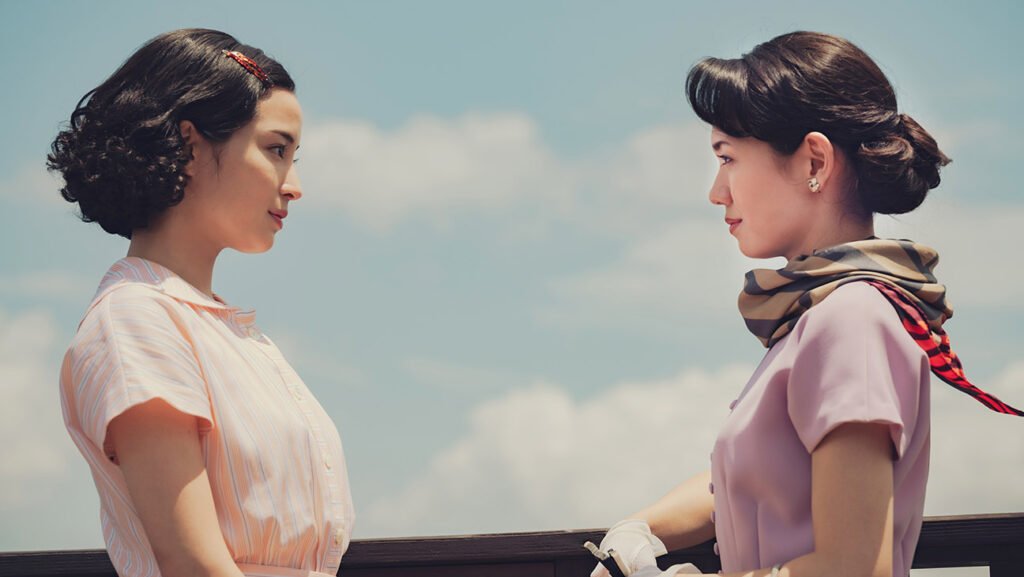In a modest home in the English countryside, a young woman rummages through her mother’s belongings. Among half-packed boxes and cluttered papers, she finds an envelope of photographs. “I’ve not seen many pictures of you in Nagasaki, you look so young,” Niki (Camila Aiko), a British-born Japanese writer says to her mother, Etsuko (Yoh Yoshida), before handing over one of the images. There’s a brusqueness to their interaction, a brevity that hints at secrets untold. Etsuko says she hadn’t intended to put the photos out and proceeds to make the bed.
These kind furtive exchanges litter A Pale View of Hills, Kei Ishikawa’s overly careful adaptation of Kazuo Ishiguro’s debut novel of the same name. The film, which premiered at Cannes in the Un Certain Regard sidebar, braids together two stories. The first is set in 1980s England, where Niki helps her mother prepare to sell their house. As the two women pack up a lifetime of belongings, Niki interviews her mother about life in post-war Japan. The young writer, who recently dropped out of university and lives in London, is working on a memoir about her family and she hopes these conversations with her mother can help her understand her older sister Keiko’s suicide. Working with DP Piotr Niemyjski, Ishikawa defines this timeline with cool tones — dark blues, muted greens and a gray pallor that haunts every frame.
A Pale View of Hills
The Bottom Line
Risk-averse to a fault.
Venue: Cannes Film Festival (Un Certain Regard)
Cast: Suzu Hirose, Fumi Nikaido, Yoh Yoshida, Camilla Aiko, Kouhei Matsushita, Tomokazu Miura
Director-screenwriter: Kei Ishikawa
2 hours 3 minutes
The second story takes place in Etsuko’s memories, a golden-hued recollection of Nagasaki in 1950. Ishikawa transports viewers to the decade after the U.S. detonated an atomic bomb on the port city which, killed hundreds of thousands of people and exposed countless others to harmful radiation. The tone is warmer in this section, the director shaping the images from this period with a bright, almost surreal visual language.
Together, these threads form a lopsided and sometimes prosaic film. Not only do the post-war Japan sequences have more resonance than the stiffer generational trauma-drama of 1980s England, but a vague sense of viewer distrust plagues this adaptation. It’s almost as if Ishikawa, eager to do the source material justice, fears that inviting any ambiguity will fail the mystery propelling Ishiguro’s novel. But a little uncertainty can be beneficial, especially when it comes to interpreting an author whose work is so haunting.
After Etsuko shares that the stress of the move has been instigating some nightmares, Niki goads her mother into telling her some stories of life in Nagasaki. The elder woman’s initial reluctance dissolves into a timid willingness as she recalls the cautious optimism saturating the city after the bomb. In those post-war years, Etsuko (now played by Suzu Hirose, Our Little Sister) and her husband Jiro (Kouhei Matsushita), a prickly man whose long hours at work make him both cranky and distant, are expecting their first child. Their relatively quiet life undergoes dramatic changes when Jiro’s father Ogata (Tomokazu Miura, Perfect Days) comes for an extended stay and Etsuko meets Sachiko (Fumi Nikaido of Shogun), a single mother who lives in a run-down cottage nearby.
The presence of both figures challenges Etsuko to confront the painful legacy of World War II as well as the role women played in post-war society. In Ogata, the expectant mother begins to understand why a younger generation feels betrayed by their elders, whom they accuse of leading them to war because of blind faith in imperialism. And through Sachiko, Etsuko expands her sense of who a Japanese woman can be in and beyond Nagasaki. Sachiko harbors dreams of leaving the city with her daughter Mariko, a solitary and malcontent child who she believes might thrive with some distance from Japan. When she meets a white American soldier named Frank, who offers to take her overseas, these dreams seem closer to becoming reality.
One of the underlying mysteries fueling Ishiguro’s novel revolves around the strange relationship between Etsuko and Sachiko. The two women, as recalled by Etsuko, can come off eerily similar and some critics have posited that one might be a projection of the other. Part of the thrill of Ishiguro’s novel is in how ambiguous the writer leaves this; the text offers clues, but few solid answers. That intentional inscrutability makes the book excitingly capricious, reflecting how nations remember or untangle painful ruptures in their history.
Ishikawa, who in addition to directing and editing A Pale View of Hills also wrote the screenplay, is most confident with the Nagasaki timeline, which conforms to a conventional family drama. It’s when Ishikawa must interweave and balance that timeline with the one in England that the director struggles a bit more. The impact of A Pale View of Hills is blunted by a tendency to over-explain and flatten.
Still, there are some highlights, including the relationship between Etsuko and Sachiko. The chemistry between Hirose and Nikaido makes their performances compelling to watch and amplifies the intriguing elements within their characters’ friendships. Those strengths coupled with Ishiguro’s popularity mean that, despite its shortcomings, A Pale View of Hills could find some stateside success.

